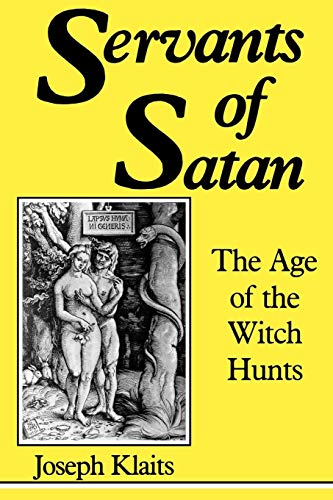
Joseph Klaits, Servants of Satan: The Age of the Witch Hunts (Bloomington, IN: Indiana University Press, 1985). 212 pages including an index, notes, bibliography, and a few woodcut plates.
We often think of witch hunting as something done in a pre-modern world. However, most of the witch trials and executions took place in a relatively short period of time as Europe was quickly becoming more modern.
The Age of the Witch Hunt
The witch frenzy began in the second half of the 16th Century and petered out in the middle of the 17th Century. This was not the Dark Ages. It was a time of enlightenment. The world was quickly advancing in philosophy and science. Of course, there had been occasional charges of witchcraft earlier in history. What made this period notable were the number of accusations and executions.
Prior to the 1550-1660 era, witchcraft prosecutions were fairly equally divided between men and women. In the late 16thCentury, most of the prosecution was against women (80% or more). While earlier witchcraft charges were against using black magic, witches were now seen as engaging in satanic worship and having sex with Satan. Klaits, in this academic work, sets out to understand what caused the rise in witchcraft cases and then the sudden departure.
The witchcraft craze followed the Reformation. Klaits is correct in noting that all churches in Western Europe were reforming during this period. The Protestant Reformation was well on its way, having started earlier in the century. The Roman Catholic Counter-Reformation was just beginning in the mid-16th century. Churches, as well as society in general, were moving from the medieval world. It was a stress-filled enviroment, brought on by religious fervor along with the political and economic changes. Klaits suggests that witch trials provided relief to an unsettled world by giving them someone to blame for the problems.
Klaits traces the shift in thinking about witchcraft from the medieval era into the 16th and early 17th Century. He explores how women became the focus (most of the women charged were elderly and single or a widow). He looks at the shifted as charges of witchcraft moved from the use of magic for evil, to satanic orgies.
The author explores a number of threads that played into this shift. One theme is how the urban and upper classes looked down on the popular folk magic of the more rural areas. This also played a role in the decline of witchcraft. The trials ended once charges began to be brought against those in the upper classes. Attitudes against women also played a role. Furthermore, the church, which had been the support system for the poor in society, stopped playing such a function after the Reformation. This led to many women living in poverty.
In a chapter on the politics of torture, Klaits discussed the role torture played. In all criminal investigations, torture was commonly used in this era. The use of torture seems to enflame the situation so that an individual charge led to multiple charges and mass hysteria. The author noted modern examples of how, with torture, stress, and the power of suggestion, people confessed to that which they did not do. In some cases, those were innocent and confessed actually believe they are guilty.
Without torture, witchcraft trials tended to be a singular event. Such was the case in England which prohibited torture in most cases. Torture often led to the victim implicating others. This fueled the hysteria and led to more trials and executions.
By the time the hysteria abated in the late 17th Century, Klaits maintains it wasn’t that people stopped believing that witchcraft. People were tired of the madness.
Most scholars, until recently, viewed witchcraft trials as a result of superstitions. Yet the trials came about during a time of great learning. Even modern people look for a scapegoat. such was the case in Nazi Germany. When we need someone to blame, we can easily fall prey to the fear of the “other.” I found myself nodding my head in agreement as I read this book with our current political climate playing in the background, with groups denigrating those who are different as the problem. This seems to happen against those who act differently, as well as minorities or those on different sides of the political spectrum.
My thoughts:
I found myself questioning some of the assumptions that Klaits made, especially of Calvin and the Swiss Reformation. while he noted that while there were fewer witch trials in Geneva than in Germany, he tends to lump both groups togethera. Having read a significant amount of Luther and Calvin, it is evident that the latter (Calvin) spent very little time focusing on the work of Satan. While Luther often felt under attack of the devil. Calvin, however, doesn’t mention witchcraft in his massive Institutes of the Christian Religion. He only occasionally mentioned Satan or the devil (23 and 9 times in over 1700 pages).
The witchcraft craze actually began after the death of the early Protestant Reformers and close to the death of Calvin. This was the “scholastic era in Protestant history (within Lutheran and Reformed/Calvinistic Churches). I am now curious on what role the scholastic’s more rigid view on theology may played in the witchcraft craze.
While this is not a book for everyone, I would recommend it on those interested in the history of this era.

Very interesting about witch hunting. It is quite unique that in Poland these practices weren’t popular at all, even though in Europe people were doing all these awful things. Stay safe everyone!
That’s interesting about Poland. While there was some witch trials in Eastern Europe, it seems that the area where most occurred were in what’s now south and central Germany.
She does not know history, there were sentences for witches in Poland. The last one was burnt in 1811. I like the history of Europe without exception 😉
Wow, Alice, that’s pretty late in history. His case is the most of the craziness died out by the mid-17th Century with a occasional trial to the early 18th century. That puts Poland a century later. Hopefully there were not many such trials.
Like Jacqui above, I am constantly amazed at things like this, slavery, concentration camps and other things we have inflicted upon mankind. You think we should have known better, even back then.
Yes, I agree, but there is something in humanity that seems to make us desire for a scapegoat. We don’t like to take responsibility for our actions or to admit that we have no clue as to why something happens. We seem to want to blame bad things on other people.
What an awful practice. I suppose they didn’t know any better but I’m constantly amazed at what humans can do to their own kind.
The interesting part is that the world was becoming modern, so you’d think they would know better. But the author does show how, even in the 20th Century, we were making similar mistakes.
A timely read. This stuff makes me so depressed, because I don’t know, I might’ve been seen as a witch and tortured like so many atypical women. But sex with Satan? That would be on-fire, quite a unique experience.
Happy Halloween, Jeff.
“On-fire”. That’s good, Robyn, thanks for the laugh. You always bring humor even to serious events!
I think it sounds very interesting and will add it to my wishlist.
I will be curious as to your take. A warning: this book probably was a revised dissertation